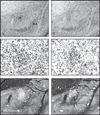Contributions of the amygdala central nucleus and ventrolateral periaqueductal grey to freezing and instrumental suppression in Pavlovian fear conditioning
- PMID: 20298722
- PMCID: PMC2862132
- DOI: 10.1016/j.bbr.2010.03.020
Contributions of the amygdala central nucleus and ventrolateral periaqueductal grey to freezing and instrumental suppression in Pavlovian fear conditioning
Abstract
In Pavlovian fear conditioning animals receive pairings of a neutral cue and an aversive stimulus such as an electric foot-shock. Through such pairings, the cue will come to elicit a central state of fear that produces a variety of autonomic and behavioral responses, among which are conditioned freezing and suppression of instrumental responding, termed conditioned suppression. The central nucleus of the amygdala (CeA) and the ventrolateral periaqueductal grey (vlPAG) has been strongly implicated in the acquisition and expression of conditioned fear. However, previous work suggests different roles for the CeA and vlPAG in fear learning maybe revealed when fear is assessed with conditioned freezing or conditioned suppression. To further explore this possibility we gave rats selective lesions of either the CeA or vlPAG and trained them in Pavlovian first-order fear conditioning as well as Pavlovian second-order fear conditioning. We concurrently assessed the acquisition of conditioned freezing and conditioned suppression. We found that vlPAG and CeA lesions impaired both first- and second-order conditioned freezing. VlPAG lesions did not impair, and CeA lesions only transiently impaired, first-order conditioned suppression. However, both vlPAG and CeA lesions impaired second-order conditioned suppression. These results suggest that the CeA and vlPAG are critically important to expressing fear through conditioned freezing but play different and less critical roles in expressing fear through conditioned suppression.
Copyright 2010 Elsevier B.V. All rights reserved.
Figures




Similar articles
-
Measuring Pavlovian fear with conditioned freezing and conditioned suppression reveals different roles for the basolateral amygdala.Brain Res. 2011 Feb 16;1374:82-9. doi: 10.1016/j.brainres.2010.12.050. Epub 2010 Dec 21. Brain Res. 2011. PMID: 21172318 Free PMC article.
-
Conditioned suppression and freezing as measures of aversive Pavlovian conditioning: effects of discrete amygdala lesions and overtraining.Behav Brain Res. 2005 Apr 30;159(2):221-33. doi: 10.1016/j.bbr.2004.11.003. Epub 2004 Dec 9. Behav Brain Res. 2005. PMID: 15817185
-
Conditioned and unconditioned fear organized in the periaqueductal gray are differentially sensitive to injections of muscimol into amygdaloid nuclei.Neurobiol Learn Mem. 2006 Jan;85(1):58-65. doi: 10.1016/j.nlm.2005.08.007. Epub 2005 Sep 28. Neurobiol Learn Mem. 2006. PMID: 16198609
-
The Neural Foundations of Reaction and Action in Aversive Motivation.Curr Top Behav Neurosci. 2016;27:171-95. doi: 10.1007/7854_2015_401. Curr Top Behav Neurosci. 2016. PMID: 26643998 Review.
-
Predator odor fear conditioning: current perspectives and new directions.Neurosci Biobehav Rev. 2008 Sep;32(7):1218-27. doi: 10.1016/j.neubiorev.2008.06.001. Epub 2008 Jun 5. Neurosci Biobehav Rev. 2008. PMID: 18577397 Free PMC article. Review.
Cited by
-
Cellular and circuit diversity determines the impact of endogenous opioids in the descending pain modulatory pathway.Front Syst Neurosci. 2022 Aug 15;16:963812. doi: 10.3389/fnsys.2022.963812. eCollection 2022. Front Syst Neurosci. 2022. PMID: 36045708 Free PMC article. Review.
-
Pavlovian Fear Conditioning Is More than You Think It Is.J Neurosci. 2023 Nov 29;43(48):8079-8087. doi: 10.1523/JNEUROSCI.0256-23.2023. J Neurosci. 2023. PMID: 38030400 Free PMC article.
-
Abundant collateralization of temporal lobe projections to the accumbens, bed nucleus of stria terminalis, central amygdala and lateral septum.Brain Struct Funct. 2017 May;222(4):1971-1988. doi: 10.1007/s00429-016-1321-y. Epub 2016 Oct 4. Brain Struct Funct. 2017. PMID: 27704219 Free PMC article.
-
Behavioral Deficits in Animal Models of Blast Traumatic Brain Injury.Front Neurol. 2020 Sep 4;11:990. doi: 10.3389/fneur.2020.00990. eCollection 2020. Front Neurol. 2020. PMID: 33013653 Free PMC article. Review.
-
Role of amygdala central nucleus in aversive learning produced by shock or by unexpected omission of food.J Neurosci. 2012 Feb 15;32(7):2461-72. doi: 10.1523/JNEUROSCI.5090-11.2012. J Neurosci. 2012. PMID: 22396420 Free PMC article.
References
-
- Davis M. Pharmacological and anatomical analysis of fear conditioning using the fear-potentiated startle paradigm. Behavioral Neuroscience. 1986;100:814–824. - PubMed
-
- Kapp BS, Frysinger RC, Gallagher M, Haselton JR. Amygdala central nucleus lesions: effect on heart rate conditioning in the rabbit. Physiology & Behavior. 1979;23:1109–1117. - PubMed
-
- Iwata J, LeDoux JE, Reis DJ. Destruction of intrinsic neurons in the lateral hypothalamus disrupts the classical conditioning of autonomic but not behavioral emotional responses in the rat. Brain Research. 1986;368:161–166. - PubMed
-
- Bolles RC, Collier AC. The effect of predictive cues on freezing in rats. Animal Learning & Behavior. 1976;4:6–8.
-
- Kim SD, Rivers S, Bevins RA, Ayres JJ. Conditioned stimulus determinants of conditioned response form in Pavlovian fear conditioning. Journal of Experimental Psychology: Animal Behavior Processes. 1996;22:87–104. - PubMed
Publication types
MeSH terms
Grants and funding
LinkOut - more resources
Full Text Sources

